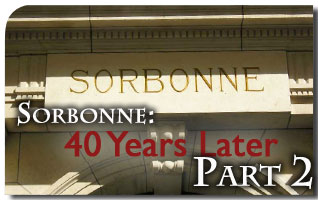by Luis Dufaur

The name Isabella — that of a 5 year-old girl killed by being thrown from a 6th floor flat in São Paulo, Brazil — still resounds in everyone’s minds. Her death has an especially terrifying aspect: the killer’s lack of moral sense. This complete lack of moral sense gives us the shivers. Even worse, this phenomenon seems ever more generalized. Whole generations have been imbued with the idea that there is neither good nor bad, or, as the revolutionaries of May 1968 put it, “It is forbidden to forbid.”[1]

"Normality"
In this “new culture” everything is permitted, everything is “normal.” Anything goes, no matter how horrendous, causing neither remorse nor pangs of conscience. In the absence of family values, crimes such as those perpetrated against Isabella take place and the culprits feel no remorse for the monstrosity committed.
Now this is not normal. Something is at work that is paralyzing the moral sense.
Factor That Anesthetizes the Sense of Good and Evil
Not too long ago, the Austrian police arrested a man for keeping his daughter prisoner in the cellar for 24 years, obliging her to have an incestuous relationship that produced seven children. One died shortly after birth without medical assistance and three never saw the light of day until the police found them.
In an incident in Germany, children looking for something in the freezer found the bodies of three little brothers whom their mother had aborted and kept there.
Crimes have always been committed in this vale of tears since the time of Cain, but one has never seen it to such an extent and with such moral insensitivity in face of unthinkable forms of evil.
So what is going through people’s minds? The most basic notion of morality, which is the instinctive respect for life, seems to have been erased from the minds of many.
To take the lives of human embryos in laboratory experiments is against nature and finds no basis in Natural Law, the foundation of all law. Nonetheless, the Brazilian Supreme Court has approved experiments on embryonic stem cells that necessarily entail the elimination of human embryos.
It is as if another human race without heart and feelings had replaced a human race formed by faith and reason.

A house in Rothenburg, Germany.
Deceitful Appearances of Normality
A few months ago I traveled through the Saar region of Germany. It was a pleasure to see the well-ordered small villages along the way. Streets were well paved, clean, and well sign-posted. The traffic was heavy, but fluid and orderly. The houses, whether belonging to the worker or middle class, were all well arranged with beautiful gardens, new or almost new cars in the driveways.
Through the windows decorated with curtains and flowers, one could see the warmth of the ambiences, well appointed and cozy.
However, occasionally, one had the strong impression that something dirty moved within this exemplary material order. This intriguing impression contradicted the palpable appearances. Appearances…how false they can be!
I entered one of the churches in the region and saw how they had been restored impeccably…but were empty. They offered an odd mix of liturgies for a handful of elderly ladies of the parish.
The enigma started to become clear. The inhabitants of those well ordered towns live the supreme disorder of not practicing any religion!
Children? Rarely were they to be found on the street. Young people? A few, but they had body piercings, jackets with rock-and-roll insignia when not out-rightly demonic. At a petrol station, a friend pointed out to me a collection of real idols and demons on sale. They were plastic, inexpensive, and probably produced in China.
Married couples? Who really knows? Fashions? I only saw a competition between all forms of extravagance. The only thing in common, imposed as if tyrannically, was that elegance and good taste had been expelled.
A Religious Revolution Under the Guise of a Cultural Change
A young German priest gave the explanation for this dramatic scenario to me. He was the chaplain to an old folks’ home impeccably maintained by the admirable zeal and charity of Franciscan nuns.
He told me, “You see how well this place is organized? The old people are very well treated by the nuns. Well, until recently there was a waiting list to obtain a place here; today we have empty rooms. Do you know why? Euthanasia. The children arrange everything beforehand with their parents. To make matters worse, 70% of the time they have them buried ‘anonymously.’ In this way they avoid extra cost and bureaucracy that might inconvenience their holidays.”
He gave further details of this sinister situation, telling me of other cases.
He confessed his astonishment in face of such a profound de-Christianization that his priestly ministry was unable to stem: “It is a cultural problem. It’s in the culture. We preach, organize prayer days, Masses, and processions. Even so, the best ones sink into this ‘culture’ and are contaminated.”
Yes, this hideous production of souls lacking in upright sentiments and scruples occurs under the guise of “cultural change.” It ends up extinguishing religion all together. Deep down, it is an articulated anti-religious revolution.
Cultural Change that Changes mentalities
In the dens of the European socialist intelligentsia, this is alluded to as a Cultural Revolution. In the United States, they use the stronger term of Cultural War.
This Cultural War has a historical rallying point much spoken of in this year of 2008: the Revolution of 1968 at the University of Paris (founded in the 13th century), more commonly known as the Sorbonne.
The Sorbonne Revolution synthesized in a single movement tendencies such as hippyism, egalitarianism, pacifism, ecology, feminism, and the “drug culture.”
In order to preach the end of the moral sense impressed upon everyone’s soul, the revolutionaries of the Sorbonne would say, “A policeman sleeps within each one of us; it is necessary to kill him.” Indeed moral sense can be compared to a policeman that continuously points out what is right and wrong, what is good and bad, what is beautiful and ugly.
They graffitied this all over the walls. Since then it has been applied in schools and universities, in different ways, by means of pedagogical, artistic, philosophical, psychological, or behavioral currents. These currents have justified styles of life, ways of being, fashions, and artistic forms “without preconceptions” that have spread through- out society, the media giving its full support.
An Example: The Criminal is Justified and the Landowner Penalized
I returned to São Paulo from Germany and strolled about the streets of my neighborhood. The difference between the little town in the Saar hit me between the eyes: barred windows, walls, electric fences, CCTV, automatic spotlights, alarms, signs announcing the security firm monitoring that building, concierges with bullet-proof windows, radio security, towers with security guards, and dogs.
In the 1970’s these same streets, houses, and buildings had pleasant and flowering gardens, hedges, small retaining walls, ornamental grates, and decorated porticoes to mark the property lines.
Everything has changed. Lack of security haunts the neighborhood where before properties were enjoyed without a care. The street now seems like a high-class prison corridor financed by the “prisoners” themselves who are frightened to death.
This change has a profound cause: Sorbonnians who filled the teaching posts of the universities, the ministries, and the courts of law preached and taught, “If you want to be happy, lynch your landowner,” or, “Those who lock the door are afraid and therefore enemies.” “Rich,” "capitalist,” “bourgeois,” and “egoist”: this “new culture” increasingly belittles the legitimate owners, and their rights tend to become morally devalued.

Danny the Red making faces at a policeman.
Crime and Madness Inspire Fashion and Art
The policeman who has always kept law and order is now public enemy no. 1. “Put a policeman within the sights of your rifle,” the revolutionary youth who started this Cultural Revolution would laughingly say. Jokingly, they would add, referring to the cobblestones, “The most beautiful sculpture is the parallelepipedon that we throw at the mouths of the policemen.” “If you find a policeman, break his face” was another phrase used to contest authority.
This “cultural” offensive turned things upside-down: the criminal is naturally good and society with its inequalities or “injustices” is what leads them to be bad, these inequalities being imposed, of course — this is another “cultural” sophism — by the “rich,” “whites,” and the “middle-class bourgeois.” The “new culture” developed a new concept of “human rights” which in fact only favors the marginalized. To those who preach this “new culture,” the “old culture” unjustly represses even the mentally disturbed.
Incredibly, they say the latter actually express a more profound aspect of human nature. Thus futuristic artists, anarchists, drug addicts, and the mentally disturbed all participate in a universal dantesque élanthat the cultural revolutionaries would argue will “produce a ‘new culture’ of the spontaneous. And these people are already experiencing a life where ‘power to the imagination’ is a reality.”
What seemed an unrealizable boast of these utopians of ’68 eventually became a marked tendency, and, in some countries, it even became law: “Let’s open the doors of the asylums, the prisons, and other institutions,” as if the prisons and psychiatric hospitals were centers of higher learning. “The ones outside are the real insane,” was written on an Italian psychiatric hospital.
A selection of slogans used by the “Cultural Revolutionaries” of the Sorbonne in 1968. Some are blatantly leftist while the effect of others can still be felt 40 years on…
It is forbidden to forbid.
Power to the Imagination.
Cultural Revolution versus a society of robots.
Be realistic, demand the impossible.
To give in a little is to capitulate too much.
Under the cobblestones, the beach.
I treat my desires as realities because
I believe in the reality of my desires.
Pleasure without limits
Alcohol kills. Take LSD.
The alarm clock rings: first humiliation of the day.
Elections, traps for idiots.
No replastering, the structure is rotten.
Neither god nor master.
How can one think freely in the shadow of a chapel?
In a society that has abolished all adventures, the only adventure left is to abolish society.
Humanity will not be happy until the last bureaucrat is hanged with the guts of the last capitalist.
Forests came before man, the desert comes afterwards.
Demolishing Respect for Superiors
Parents, grandparents, superiors, teachers, bosses, public authorities, professionals all used to be the object of a specific form of respect. The Cultural Revolution of 1968 made sure all these forms of respect, veneration, protection, and obedience were demolished. It wishes to eliminate all laws, countries, and boundaries.
It does not use the brutal bolshevist methods or the sadistic re-education sessions of the Cultural Revolution of Mao Tsé-Tung.
The ’68 Cultural Revolution’s weapon is ridicule. It publicly scorns all these values while sporting a smile that is goodie-goodie, naïve, and spontaneous. The photo of Daniel Cohn-Bendit, the leader of the Revolution of May 1968, making faces at a policeman, is the new form of protest. Phrases mockingly chanted by the new protesters were: “Insolence is the new weapon of the revolutionary” and “Respect is gone. Be careful not to bring it back.”
Radical Cultural Destruction of Teaching
In the school, an aura of venerability enveloped the teacher. The very institution of teaching also participated in this. In the “cultural war,” however, the professor, the teacher, the representative ofGod, even the father and the mother became bad. Why? Because they repress! The students who insult them, on the other hand, are innocent and even applauded.
“What is a teacher, a God? One and the other represent a father and exert an oppressive function by definition,” the revolutionaries of ’68 proclaimed. Openly they proposed to the students, “No longer say, ‘Mr. so and so, but rather, get lost idiot.’” This cultural inversion led to the ferocious slogan, “Eat your professors,” and to others even more anarchic: “Neither god nor master.” In this point, as in others, the French Revolution inspired May ‘68. In his speech of 3 December 1792 in the Convention, Robespierre demanded the immediate execution of the King: “To guarantee the nascent Republic it is necessary to engrave profoundly in the hearts contempt for royalty.”[2]
Lack of discipline and chaos devastated the educational institutions, teaching material was binned, and classrooms vandalized.
For the Cultural Revolution, this destruction is a triumph: “The destruction of teaching material of a bourgeoisie university is an expression of revolutionary art,” they exclaimed in Paris. “We will have good professors on the day each one is his own professor.” If the professor no longer has a reason for being, we have anarchy.

The Progress of Civilization is Contested “Culturally”
In 1970 there was still strong belief that progress would ultimately conquer illness, poverty, and ignorance. We were increasingly rich, healthy, satisfied, and educated. It seemed mankind would attain ever-new heights of happiness and civilization.
The ’68 Cultural Revolution instilled a lack of interest in this future: “Stop the world; I want to go back,” The Sorbonnians and the hippies would say. They idolized the contrary of a cultured and successful man. In mocking tones they graffitied the walls of Paris with the slogan “I dream of being a happy imbecile,” perfectly symbolized by the dreamy gaze of the hippy.
In the 1970’s, it was hoped that a new economic era of prosperity would come. Work multiplied by technology would expand without limits. However, the prophets of May 1968 had other ideas: “Never work” and “The economy is wounded, let it die.”
Progress was considered the enemy: “Forests came before man, the desert comes afterwards.” Today the radical ecological movement proclaims the same sophism — with or without scientific pretexts — to stop civilization from expanding.
Sacraments of the Cultural Liberation
In the 1950’s, rock and roll emerged. By 1970, it had found a solid anchorage within the youth culture. Youth abandoned themselves to the delirium of drugs having at first been prepared by the rhythmic frenzy and strident anti-melody of performers such as Elvis Presley, and then openly encouraged by rock bands that came later such as the Rolling Stones. The Beatles exalted LSD (“Lucy in the Sky with Diamonds”), and the film Yellow Submarine showed to the uninitiated the effects of a “trip” caused by taking hallucinogenic drugs.
The clever slogans of May ’68 consecrated this tendency. “Alcohol kills, take LSD” was proclaimed without shame. They then said say tobacco was bad but marijuana was therapeutic; that LSD expands the frontiers of creativity or that it helps to escape from the oppression of reality. The “drug culture” gained ground and there were marches that it be legalized.
Whoever might be against this legalization was called a repressor of our expanded human rights.
Drugs were one of the instruments to establish “power to the imagination,” but it was not the only one. The new technologies of the image along with ideologues such as McLuhan, Marx, Mao, and Marcuse all helped to feed the toxic illusion of a life without logic and reason.
There was more. The ’68 Revolution took on practices of witchcraft as well as self-hypnotic practices from the East. The Beatles returned from India with a spiritual guru, Maharishi Yogui, and the practice caught on.
We soon saw centers for yoga, transcendental meditation, and other oriental “techniques” to enter into contact with energies from the other world. People would frequent these centers as one going to a medical clinic. This was the New Age-being introduced in the name of a new culture for a new humanity. Drugs, hyper-technology, and occultism became the “sacraments” of “cultural liberation.”
The Cultural Revolution’s Anti-Christian Hatred
Within its innermost circles the agents of May ’68 would say with hatred, “How can one think freely in the shadow of a chapel?;” “Let us de-Christianize the Sorbonne;” even worse: “Even if God existed, it would be necessary to abolish Him;” “The sacred, this is the enemy;” “Neither god nor master. I am God.” Even more explicitly they would blaspheme, “Down with the scum of Nazareth.” Here the “cultural war” shows its religious dimension.
Putting Everyone in His Place
Those producing the slogans of ’68 were able to do with direct phrases what philosophers needed interminable treatises to expound. A key phrase that summarized the immense scope of its “cultural mutations” was, “Cultural Revolution versus a society of robots.” This phrase presupposes that whoever obeys his natural superiors is someone without intelligence and free will.
Yet another was, “Culture is the inversion of life.” This is the clearest definition of the ’68 Cultural Revolution: to turn the world inside out under the guise of “culture.” It did not only want to modify it here and there, but to install the most horrible opposite in every nook and cranny.
To prove the point, a journal during May of 1968 announced that as part of the Revolution, which is much more profound than the French Revolution of 1789, people would no longer shake hands with their right hands, but with left hands. Even though this commentary was a bit utopist, we have to admit that this Revolution spread even more extravagant ways of being than a handshake with the left hand.
Footnotes:
 Phillipe Darwin, Le petit libre rougede Mai 68, City Editions, Paris 2008. All slogans in this article are from the same source. The side bar also includes some from John Lichfield, Signs of the Times: The Sayings and Slogans of 1968, The Independent, 22/2/08.
Phillipe Darwin, Le petit libre rougede Mai 68, City Editions, Paris 2008. All slogans in this article are from the same source. The side bar also includes some from John Lichfield, Signs of the Times: The Sayings and Slogans of 1968, The Independent, 22/2/08.  Le livre Noir de La Révolution Française, Editions du Cerf, 2008, p. 767.
Le livre Noir de La Révolution Française, Editions du Cerf, 2008, p. 767.

No comments:
Post a Comment